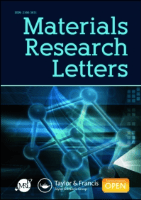
Materials Research Letters
Scope & Guideline
Exploring New Horizons in Materials Science
Introduction
Aims and Scopes
- Advanced Materials Characterization:
The journal publishes studies employing advanced characterization techniques such as in situ electron microscopy, X-ray diffraction, and synchrotron methods to explore microstructural properties at the atomic and nanoscale. - Innovative Materials Processing Techniques:
Research on novel fabrication methods, particularly additive manufacturing and severe plastic deformation, is a consistent theme, highlighting how these techniques can enhance material properties. - Mechanisms of Strength and Ductility:
There is a strong emphasis on understanding the mechanisms that govern the strength-ductility synergy in various materials, particularly high-entropy alloys and composites, helping to bridge the gap between theoretical predictions and practical applications. - Multiscale Material Design:
The journal features research that addresses multiscale approaches to material design, integrating computational methods with experimental validation to optimize material performance. - Application-Driven Research:
Research often focuses on the applicability of materials in real-world scenarios, such as biomedical applications, energy storage, and structural integrity, reflecting the journal's commitment to impactful science.
Trending and Emerging
- High-Entropy Alloys (HEAs):
Research on HEAs has surged, focusing on their unique mechanical and thermal properties, which enable promising applications in extreme environments and advanced engineering. - Additive Manufacturing Innovations:
The rapid advancement of additive manufacturing techniques continues to be a hot topic, with studies exploring new materials, processes, and applications that enhance performance and reduce costs. - Functional Nanomaterials:
There is an increasing focus on nanomaterials with specialized functions, such as catalysts, sensors, and energy storage materials, driven by their potential to revolutionize various industries. - Biomimetic and Bioinspired Materials:
Research exploring materials designed based on biological systems is gaining traction, reflecting a growing interest in sustainability and efficiency in material design. - Machine Learning and AI in Materials Science:
The integration of machine learning and artificial intelligence for materials discovery and optimization is emerging as a critical area of research, indicating a trend towards data-driven approaches in materials science.
Declining or Waning
- Traditional Alloy Systems:
Research focused on classical alloy systems, particularly those that do not incorporate advanced processing techniques or multi-principal elements, has seen a decrease as the field moves towards more complex materials. - Basic Mechanical Testing:
Papers that primarily report on basic mechanical testing of materials without novel insights into mechanisms or applications are becoming less common, as the focus shifts to more integrated approaches involving advanced characterization and processing. - Single-Property Studies:
There is a waning interest in studies that examine single properties in isolation, such as tensile strength or hardness, without a comprehensive analysis of how these properties interact or contribute to overall material performance. - Conventional Ceramics:
While ceramics remain important, the journal has seen a decline in papers focused solely on traditional ceramic materials, particularly those lacking innovative processing or functional enhancements. - Theoretical Studies Without Experimental Validation:
Research that relies solely on theoretical models without robust experimental validation is less favored, as the journal emphasizes the importance of empirical data to support theoretical claims.
Similar Journals

JOURNAL OF MATERIALS SCIENCE
Advancing the Frontiers of Materials InnovationJOURNAL OF MATERIALS SCIENCE, published by SPRINGER, stands as a highly regarded periodical in the field of materials science, delivering impactful research since its inception in 1966. With an impressive Q1 ranking in both Mechanical Engineering and Mechanics of Materials, alongside strong Q2 positions in Ceramics, Composites, and General Materials Science, this journal serves as a pivotal resource for scholars and practitioners alike. It offers insightful contributions that span a diverse range of topics, from emerging materials to advanced applications in engineering. With a robust Scopus ranking reflecting its global influence—ranking 91 out of 672 in Mechanical Engineering and 63 out of 398 in Mechanics of Materials—the JOURNAL OF MATERIALS SCIENCE maintains an essential role in advancing the understanding and innovation within the discipline. Researchers, professionals, and students are encouraged to access this esteemed journal to keep abreast of groundbreaking findings and methodologies that shape the future of materials science.
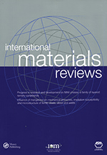
INTERNATIONAL MATERIALS REVIEWS
Connecting Theory and Practice in Materials EngineeringINTERNATIONAL MATERIALS REVIEWS, published by SAGE Publications Inc, is a leading journal dedicated to the comprehensive analysis of contemporary research in the fields of materials chemistry, mechanical engineering, mechanics of materials, and the study of metals and alloys. With an impressive impact factor and a Q1 ranking across multiple categories such as Materials Chemistry and Mechanical Engineering in 2023, it ranks amongst the top journals for innovative materials research. The journal has a long-standing history since its inception in 1987 and continues to serve as a crucial resource for academics and professionals alike. Although it is not open access, it is renowned for its rigorous peer-review process and its commitment to disseminating high-quality materials science research globally. Researchers, students, and industry professionals benefit greatly from the journal's insightful reviews, both for the advancement of theoretical knowledge and practical applications within the fast-evolving materials field.

npj Computational Materials
Pioneering Research in Computational Materials Science.npj Computational Materials is a premier open-access journal published by the esteemed NATURE PORTFOLIO since its inception in 2015, dedicated to advancing the interdisciplinary fields of computational materials science and engineering. With an impressively robust impact, the journal has achieved Q1 rankings across multiple disciplines, including Computer Science Applications, Materials Science, and Mechanics of Materials, making it a leading platform for disseminating innovative research. Researchers and professionals benefit from its high visibility and accessibility, given the open-access format that allows for a global reach. The journal continues to foster the development of computational methods and simulations that drive forward the design and deployment of advanced materials, positioning itself as an essential resource for academics and practitioners alike. By bridging the gap between theoretical models and practical applications, npj Computational Materials plays a crucial role in shaping the future of materials research.
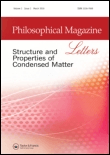
PHILOSOPHICAL MAGAZINE LETTERS
Unlocking the Mysteries of Matter Since 1981PHILOSOPHICAL MAGAZINE LETTERS, published by Taylor & Francis Ltd, is a prestigious open-access journal dedicated to the vibrant field of Condensed Matter Physics. With an ISSN of 0950-0839 and an E-ISSN of 1362-3036, the journal has been a pivotal platform for disseminating crucial research findings since its inception in 1981. As of 2023, it transitioned to open access, enhancing visibility and accessibility for researchers worldwide. Located in the United Kingdom, it holds a rank of #268 out of 434 in the field, placing it in the 38th percentile for its category. Its recent categorization as Q3 in Condensed Matter Physics reflects its commitment to advancing knowledge through rigorous peer-reviewed articles. The journal welcomes contributions that push the boundaries of understanding in condensed matter, fostering innovation and collaboration among physicists, professionals, and students alike. Explore groundbreaking research and join a community dedicated to the exploration of the fundamental properties of matter.

Journal of Metals Materials and Minerals
Connecting Researchers in Metals and Materials EngineeringJournal of Metals Materials and Minerals (ISSN: 0857-6149) is a renowned academic publication dedicated to the interdisciplinary fields of metallurgical science, materials engineering, and mineralogy. Published by Chulalongkorn University, Metallurgy & Materials Science Research Institute in Thailand, this journal serves as a pivotal platform for researchers to disseminate their findings and explore innovative applications related to metals, ceramics, polymers, and biomaterials. Although the journal does not currently adopt an open-access model, it provides insightful content that facilitates knowledge sharing among professionals and academics alike. The journal has established its credibility with impressive Scopus ranking percentiles, particularly in categories such as Metals and Alloys and Ceramics and Composites. With an emphasis on advancing the understanding of materials science from 2017 to 2024, the Journal of Metals Materials and Minerals remains an essential resource for those striving to contribute to and stay informed about the latest trends and breakthroughs in these dynamic fields.

Multiscale and Multidisciplinary Modeling Experiments and Design
Fostering a global community for cutting-edge modeling experiments.Multiscale and Multidisciplinary Modeling Experiments and Design is a dynamic journal published by SPRINGERNATURE, dedicated to advancing the fields of applied mathematics, materials science, and mechanics of materials. With an ISSN of 2520-8160 and an E-ISSN of 2520-8179, this journal provides a platform for innovative research and multidisciplinary approaches that address complex modeling and experimental challenges from 2018 to 2024. Ranked in the Q3 quartile across its categories and holding respectable positions within Scopus rankings, it serves as a vital resource for researchers and professionals seeking to explore emerging techniques and solutions in their fields. Despite its recent inception, Multiscale and Multidisciplinary Modeling Experiments and Design fosters a collaborative environment for knowledge exchange, making it essential for anyone at the forefront of scientific discovery. Open access availability ensures that the groundbreaking research published within is accessible to a broad audience, promoting global collaboration and innovations.

METALS AND MATERIALS INTERNATIONAL
Elevating global discourse in materials innovation.METALS AND MATERIALS INTERNATIONAL, published by the Korean Institute of Metals and Materials, is a prestigious journal dedicated to the advancement of research in the fields of materials science and engineering. With an ISSN of 1598-9623 and a robust e-ISSN of 2005-4149, this journal has established itself as a crucial platform for disseminating innovative findings and key advancements that span condensed matter physics, materials chemistry, mechanics of materials, and the technology of metals and alloys. Its Q1 rankings in multiple categories attest to its high impact and relevance in the academic community, placing it among the top journals in its fields with Scopus rankings that reflect a strong international footprint. Here, researchers, professionals, and students can access cutting-edge research and insights, fostering collaboration and exploration of new materials and their applications. With a commitment to excellence and a convergence of knowledge from 1996 to 2024, METALS AND MATERIALS INTERNATIONAL continues to enhance our understanding of materials and their transformative impact on technology and engineering.
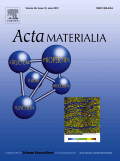
ACTA MATERIALIA
Shaping Tomorrow's Materials TodayACTA MATERIALIA is a premier journal in the field of materials science, published by PERGAMON-ELSEVIER SCIENCE LTD. With an ISSN of 1359-6454 and an E-ISSN of 1873-2453, this esteemed journal serves as a vital platform for disseminating high-quality research across various critical domains, including ceramics and composites, electronic, optical and magnetic materials, metals and alloys, and polymers and plastics. Recognized for its impact in the field, ACTA MATERIALIA boasts a remarkable standing, featuring a Q1 ranking in multiple categories as of 2023, solidifying its importance among the top journals in materials science. Researchers and professionals benefit from open access options, ensuring that groundbreaking findings are available to a global audience. Operating out of the United Kingdom, ACTA MATERIALIA strives to advance knowledge and innovation within the materials science community, making it an invaluable resource for academics, industrial professionals, and students dedicated to the future of material engineering and technology.

Oxford Open Materials Science
Empowering Research Through Open AccessOxford Open Materials Science is a pioneering peer-reviewed journal published by Oxford University Press that serves as a leading platform for the open-access dissemination of original research in the field of materials science. With its inception in 2021, the journal has quickly established itself as a significant contributor to the scholarly community, achieving a commendable Q2 ranking in the Materials Science (miscellaneous) category as of 2023, and holding the 252nd position out of 463 in the Scopus ranking for general materials science. This journal not only fosters innovative research and collaboration among experts, practitioners, and students but also emphasizes the importance of unrestricted access to knowledge. With the open-access model, it ensures that high-quality research is universally accessible, paving the way for advancements in material applications and technologies. Oxford Open Materials Science is dedicated to promoting the exchange of ideas and findings essential for the scientific progress of materials science, making it an invaluable resource for today's researchers and industry professionals.
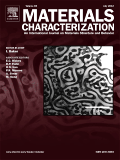
MATERIALS CHARACTERIZATION
Bridging Disciplines in Materials ScienceMATERIALS CHARACTERIZATION is a leading international journal dedicated to the advancement of knowledge in the field of materials science and engineering. Published by Elsevier Science Inc, this esteemed journal has been disseminating vital research since 1970 and continues to be essential for scholars and industry professionals alike. With an impressive impact reflected in its Q1 quartile rankings across several categories—including Condensed Matter Physics, Materials Science, Mechanical Engineering, and Mechanics of Materials—MATERIALS CHARACTERIZATION stands out as a premier outlet for innovative studies and technical advancements. Researchers can access a wealth of peer-reviewed articles that explore properties, characterization techniques, and applications of materials, fostering interdisciplinary collaboration. With a commitment to high-quality research and comprehensive review processes, the journal plays a crucial role in shaping the future of materials science, making it an invaluable resource for anyone invested in this dynamic field.